
Chebe Powder From Chad for Natural Hair Growth | 4C Natural Afro Hair
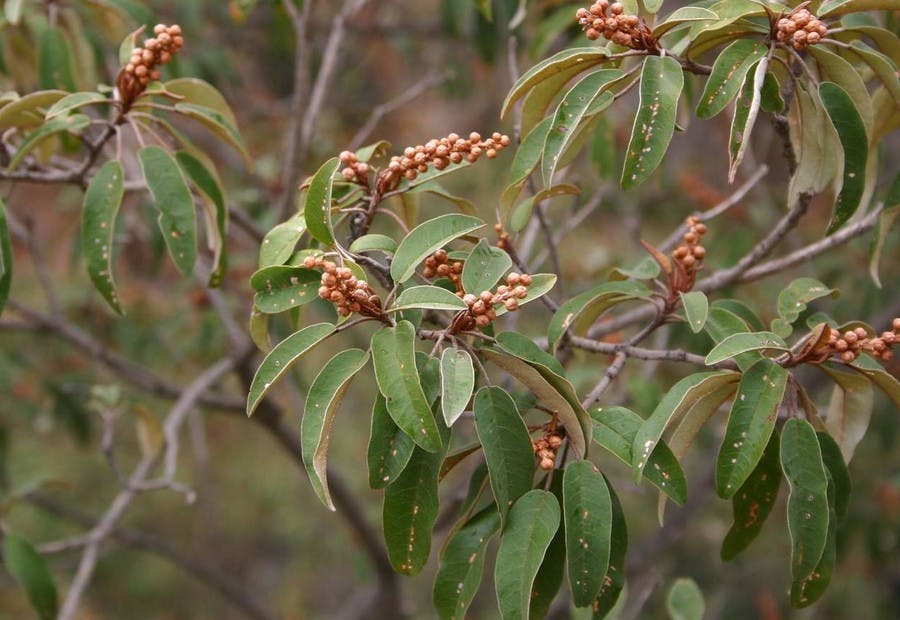
Chebe Powder for Natural Hair Growth | 4C Hair African Hair
A very warm welcome to the Jostylin blog! With this blog, I aim to give you more information about using Chebe Powder to grow long natural hair.
Main Topics On Using Chebe Powder For Natural Hair Growth
The main topics I will cover in this blog are:
- What is ‘Chebe Powder’
- The countries where the plant is grown
- The recipe for the powder
- The hair types of the women who use it in Chad
- If their hair growth is genetic
- Whether I feel it will help with growth/ length/moisture retention on 4C kinky hair and
- Where you can buy Chebe powder.
I have also created another post called ‘African Tribal Hair & Beauty Secrets – Alternative Plants to Chebe Powder‘. In that post, I will be regularly updating with any new ingredients or tribal hair recipes I find. Also, visit the article called Ayurvedic Herbs for Natural Hair Growth for further information on using herbs for natural hair.
Just a to note; my articles tend to be very detailed so it’s always a good idea to bookmark them. Also, check out my article on how to grow natural hair fast if you're looking for hair growth tips.
History of Chebe Powder For Natural Hair Growth
A few years back, Miss Sahel Vlog, a Youtube hair blogger from Chad, West Africa takes us on an exciting journey to visit the Basara Arab women of the West African Sahara Sahel region.
The video reveals a beautiful hair care recipe called ‘Chebe powder/Chewe’, which they claim to be the secret to growing black hair long.
By researching the beauty secrets of ancient African tribes, we not only gain valuable access to our ancestral and indigenous knowledge of plants, we now have an open door to recipes and ingredients that can help grow hair, look after our skin and overall health.
What is Chebe Powder?
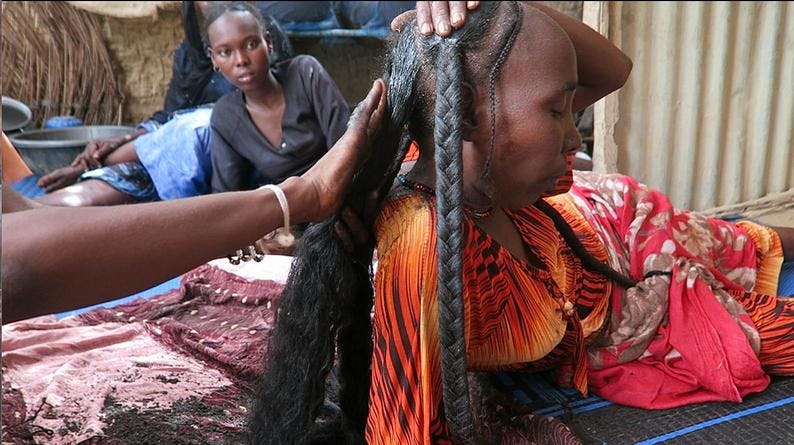
So essentially there is no such thing as ‘Chebe Seeds’. Chebe is simply a nickname given to the name of the finished powdered hair product by locals in Chad for natural hair growth. According to Miss Sahel Vlogs, various ingredients are used in this mixture, with the main ingredient which they call ‘Chewe’ or ‘Chebe’. The other ingredients include Mahlaba (Cherry kernels), Samour (Mastic Gum), Clove & Sudanese Khumra Perfume oils.
The scientific name of the plant which they refer to as ‘Chebe’ is called Croton Zambesicus (Also known as Lavender Croton). It is a shrub and it is actually grown all over Africa, primarily in West Africa, mainly Ghana, Nigeria, Gambia and Burkina Faso.
It is found planted in front of houses, mainly in towns and villages and is often used as a medicinal plant. The Yoruba people in Nigeria use it as a spiritual weapon to ward off witchcraft, and it goes by the name of ‘Ewe Ajekobale’. They also successfully use it to help cure diabetes. If you are Nigerian and you live in Lagos, you should be able to find it everywhere as it is a very common plant in South West Nigeria.
Other Plant Strains Similar to Chebe Powder From Chad
Another strain of the plant goes by the name of ‘Croton Gratissimus’ (Lavender Feverberry). It is found in other tropical African countries like Cameroon, Namibia, Botswana, South Africa, Kenya, Zambia and Zimbabwe (Goes by the name of Gunukira in Shona language). Luckily for those living in Africa, it is everywhere, you just have to learn how to identify it.
A third strain of the Croton family is Croton Tiglium, which has been successful in treating alopecia areata, an auto immune condition that causes hair loss. However, I wouldn’t recommend using this type without a specialist, due to its high toxicity, which can cause severe diarrhoea and abdominal cramps.croton
For safety reasons: There are various different strains of croton, some which can be poisonous, so do not mistake any other type of Croton for Croton Zambesicus or Gratissimus.
Can I Find Chebe Powder In USA?
Sadly for those outside of Africa, neither Croton Zambesicus or Gratissimus is grown in North America or the UK, so it will be very hard to find. If you can’t get your hands on Chebe, don’t worry! There are many other alternative plants to Chebe used by neighbouring tribes of the West African Sahel who also have very long hair, such as the Tuareg and Fulani. For those recipes, please continue reading. Most likely you will find some of those ingredients in your country. Chebe is not the only plant you can use.
Caution: Please also be cautious when using medicinal herbs and make sure you do further research about the side effects, so please follow the instructions in Miss Sahel’s video properly. I am very much into horticulture and I travel very often to Ghana & Turkey, where medicinal plants are being used successfully for various reasons, such as curing Malaria, so please be cautious.
NOTE: Since posting this article, we have been receiving many emails on whether we can sell the Chebe seeds (lavender croton seeds) from Ghana. With respect to Africa, simply exporting seeds does not bring many benefits to the people or economy. We simply can’t go around plucking plants and selling seeds without growing new plants first. It’s not sustainable at all unless the seeds are available in large quantities, which requires much extensive research. So, until further research is done, it makes more sense to sell the products ready as a powder in branded packaging.
Chad is one of the poorest countries in Africa, despite the fact that the country sits on large deposits of crude oil. The United Nations recently reported in May this year that there is a high risk of famine in the Lake Chad Basin, which is an area that sits at the borders of Chad & Northern Nigeria. So all the more reason to help Africa’s Sahel region with an efficient sustainable development plan.
Our natural hair shop online was opened in 2016 with the aim of exporting products already formulated and packaged within the African continent, as we feel this is more beneficial to the economy than simply selling raw ingredients in bulk.
Chebe Powder – Can It Help With Natural Hair Growth On 4C African Hair?
So before we discuss hair types and genetics, and how to use Chebe powder for natural hair growth I first want to introduce various other hair recipes from neighbouring tribes of the Basara Arabs who also live within the Sahara Sahel region and have long hair.
Sahelian tribes take their hair care maintenance very seriously. Traditionally in African and Arabian countries, women use dairy products, herbal extracts and essential oils like lavender and jasmine to take care of their hair. You will find all these ingredients mainly being used by these Sahelian tribes. Unkempt hair is not a good look at all.
So let’s take a look at the Tuareg and Fulani hair care ingredients! Similar to the Basara Arabs, the Tuaregs (a neighbouring tribe found in Northern Nigeria, Chad, Mali, Niger & Libya) apply a very similar powder and shampoo that helps their hair retain moisture. This enables their hair to stay strong and healthy, well maintained and in good condition. Ever wondered why Tuaregs have very shiny hair? It is a range of natural extracts sourced from the same tuareg hairSahelian landscape as the Basara Arabs. Luckily, most of these ingredients are very easy to find for those living outside of Africa.
They first infuse the leaves of talekkodt (black benniseed /black sesame seeds), deje (white raisin tree) and ataghantagh (Rogeria adenophylla), in water to produce hair cleansers. You do not need all three ingredients, one or two of the three will do just fine.
To create a perfumed hair powder, Tuareg women crush the dried flowers of tajalalt, (Mitragyna inermis) and mix it with another fragrant powder derived from the bark of the shittah tree (Acacia seya/mastic gum). This is a very similar powder to that of Chebe, but as you can see it only includes two ingredients and not five. This fragrant powder is particularly favoured by pregnant women.
By consistently rubbing and coating their hair with these aromatic herbal pomades and fine black sand, they enhance lustre in their hair before intricately braiding it into a number of different unique hairstyles. This is a very similar routine you saw in the video by Miss Sahel. You can see how shiny and healthy the young girl’s hair is in the picture above is.
As a hair tonic, they use camel urine, which perfumes their hair, leaving it glossy, lustrous and thick while also preventing dandruff. (Please don’t go looking for camel piss online. Distilled water infused with rosemary essential oil will work just well).
To put it simply, you can use a variety of seeds to obtain the same lustrous hair as the Sahelian tribes. Even Fenugreek seeds can give the same results as Chebe. Fenugreek seeds
Fenugreek seeds helps to thicken and grow hair. All you have to do is take fenugreek seeds and let it soak in water for a night. Then you can combine the same with other ingredients to make a great hair pack.
If you are based outside of Africa, you should be able to find Fenugreek seeds & Sesame seeds. There are many ingredients you can use. Go ahead and just improvise!
Once again: Please also be cautious when using medicinal herbs and make sure you do further research about the side effects. Click here for more African hair growth recipes.
Who Are The Fulani, Tuaregs, Basara/Baggara Arabs & Sahelian Tribes ? How Do They Use Chebe Powder From Chad for Natural Hair Growth?
To fully understand whether the Chebe powder from Chad will work for the 4C natural hair growth, I personally feel that it is important to study the background and hair types of these Sahelian & Arab speaking tribes. Who are they? Do they all have 4C hair? Are they mixed? Is their long hair genetic? I noticed that there has been a lot of debate online surrounding these questions and I will approach the answers by studying the Arab tribes of the Sahel and their neighbours.
Firstly, let me begin by saying that I am a Southern Nigerian who spends much of my time in Ghana, UK & Turkey. Many of my family members live in Northern Nigeria (Abuja), so I am quite familiar with various Sahelian tribes of West Africa, in particular, the Fulanis, Kanuri, Hausa, Shuwa Arabs & Tuareg Berbers who live in the middle belt and far north of Nigeria. Even in Ghana, we have many Fulani and Tuareg people.
The Sahel region is the long savannah area immediately under the Sahara that connects North Africa to West Africa & Sub Saharan African. The area touches the countries of Northern Nigeria, Chad, Mali, Senegal, Burkina Faso, Niger, Northern Ghana, Mauritania, Southern Libya, Southern Algeria, Southern Morocco & Sudan.famineinsahel2
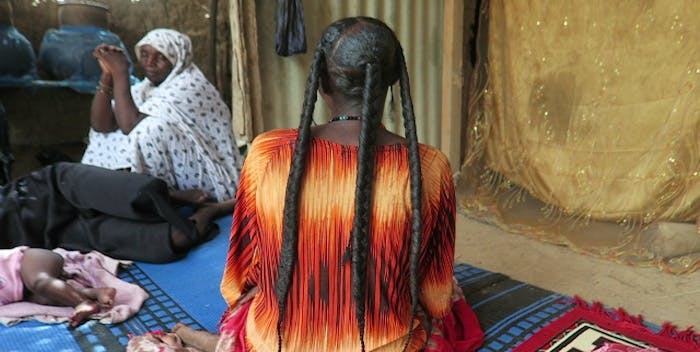
The Sahel belt is often referred to as the ‘transitional zone’ between the desert and Sub-Saharan Africa, and this transition is also reflected in the physical characteristics of the people who live there. Looser curls are a very common feature there. The people who live on the Sahel are called ‘Sahelians’ and genetics commonly found in North Africa, West Africa, East Africa, Southern Africa, Middle East and even Central Asia and Europe (Ottoman Turks), can be found amongst these people.
There are many tribes local to this region such as the Tuaregs, Fulani, Hausa, Basara Arabs, Shuwa Arabs, Tebu/Toubou, Kanuri, Sanhaja, Zenagha, Zaghawa, Soninke, Mandinke and much more. Most (if not all) of these tribes in the Sahel region are part of the ‘Afro-Asiatic’ linguistic group, and many are sometimes mistaken for East African Horners due to their physical characteristics and ‘Arabic’ names.
Are Sahelian Tribes Mixed?
I know this subject of admixture is a very sensitive matter, so I will approach this topic based on DNA evidence in addition to social relations. We will discuss the DNA results of these tribes very soon.
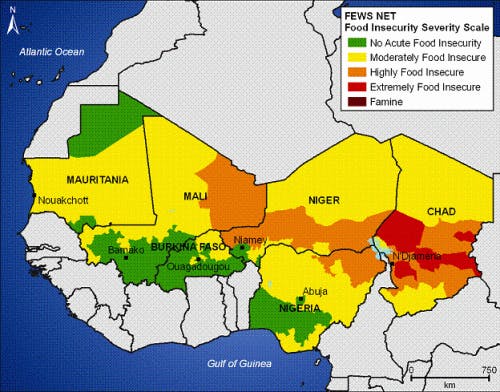
From my studies, I have come to the conclusion that yes they are mixed, but not all of them. Many of these tribes such as the Tuaregs and Basara Arabs are mixed heavily with North African Amazigh Berbers & to a lesser extent Arabs, whilst others remain more Sub Saharan African derived such as the Fulani, Hausa, Soninke & Kanuri.
When back home in Nigeria and Ghana, I can easily spot these Sahelian tribes – a good indication is that their physical features are very distinct from the more Southern tribes. Their curls are looser, and sometimes even have straight hair. To say they are ‘not black’ is objectionable, however, they are most certainly distinguishable from the Southern tribes. The Tuaregs of Mali, in particular, do not very often refer to themselves as ‘black’, hence their quest for the separation of Northern Mali. Even in Sudan, Black South Sudan Vs Afro-Arab North Sudan was an issue a few years ago before their separation.
Here in Ghana, many Sahelian kids (mainly Tuareg Berbers) have sadly resorted to begging, which started during the Sahel food crises in 2005 – Niger and Chad suffered grain deficits of around 224,000 and 217,000 tons (The Sahel is a landlocked region, so the risk of famine is always there). This food deficit led to the migration of Niger & Chad Tuaregs away from the Sahel, and towards the darker skinned coastal areas of West Africa. In Accra, the capital of Ghana, the Tuareg Berber kids are easy to identify as they are clearly looking different from the majority of the Ghanaians. In the video below, you can distinguish very clearly the difference in hair types & physical characteristics that I am referring to:
DNA Results of Various Sahelian Tribes
Many DNA studies have revealed that many of these Tuareg & Arab speaking Sahelian tribes in Chad and Sudan are predominantly derived from a mix of North African Amazigh Berbers and other Sub Saharan African natives including West Africa & Horn of Africa. The North African DNA markers given by most DNA companies point mainly to the Amazigh Berber tribe, who are the whitest of all Berber tribes (some literally have blonde hair and blue eyes). Although the Tuareg Berbers do not speak Arabic, they are, however, very closely related to their Arabic speaking neighbours in the Sahel, both genetically & historically.
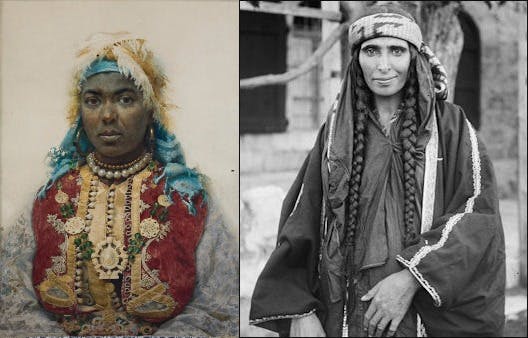
20120210-Bedouin_woman_(1898_-_1914)
Even though the Afro-Arab tribes of Chad and Sudan tend to refer to themselves as ‘Arabs’, they mostly derive from a mixture of North African Amazigh Berber & black African, just like Tuaregs. Click here for more on Sudanese DNA Test Results. The Middle Eastern (Arab) DNA is most often very small and derives from the Bedouin Arab tribes. The Horner tribes in Ethiopia and Somalia tend to have more Middle Eastern DNA markers than the Sahelian tribes.
The Basara Arabs of Chad are closely related to the Shuwa Arabs of Northern Nigeria & The Baggara of Sudan. They are generally all subgroups of the Bedouin Arab Al-Baggara tribe that entered Africa from the Middle East. The Bedouin Arab tribes were a brown skin Middle Eastern Arab tribe with long silky hair, that is often braided in a similar fashion to many African tribes (see picture). The Arabic cultural influence was very strong, even though the genetic admixture was small. These African and Berber tribes have heavily adopted the Arab culture and language.
Today the Arab African tribes have a variety of looks. Some are more genetically black African than others. (The Shuwa Arabs in Nigeria appear more black African derived than the Basara Arabs of Sudan and Chad who appear more North African Berber derived).
The Toubou tribes belong to the ‘Gorane’ group which in Chad Arabic refers to the ancient ‘Garamantes’ people (an Ancient North African people prior to Arab & Roman conquests). They are more African derived than the Arab tribes but are also mixed with North African Berbers.
Others such as the Fulani originate in Guinea (Fouta Djallon) and have been in the Sahel for much longer. Fulanis have also mixed with North African Berbers, but to a lesser extent than their Afro-Arab neighbours. Fulanis tend to have about 15% North African Amazigh Berber DNA. Click here for Fulani DNA results. Additionally, some of these tribes such as the Zenagha, Toubou, Fulani and Tuareg have been referenced by scholars such as Ivan Van Sertima, to be the jose_tapiro_y_baro_-_the_bride_1900_watercolor_museu_dart_i_historia_de_reus_small.600x0descendants of the ‘Black Moors’ who accompanied the Arabs and Berbers to colonize Southern Spain. (see image of an 18th century Spanish painting by Jose Tapiro y Baro, of a black Moor dressed in Libyan attire. The same attire is still currently found worn by the Tuareg and Arab tribes of Ghadames, Southern Libya).
So historically, we can conclude that both the Arab tribes and Tuareg Berber tribes of the Sahel are a product of mixed origins that include North African Berbers, Black Sub Saharan Africans and to a lesser extent Bedouin Arabs who came mainly from Libya or Yemen, settled within the Sahel region of Africa and mixed with the darker skinned natives.
One thing is for sure, some of the Sahelian women in Northern Nigeria, such as the Shuwa Arabs & Tuaregs, are known for their loose curly hair texture (most definitely looser than Southern Nigerians). When their hair is not covered with a hijab, it is common to see it reaching waist length, with or without Chebe being used.
So is their hair length genetic or is it the Chebe? It’s hard to say, as there are many who also have short kinkier hair, who are closely related to those that have long hair. When it comes to the Tuareg tribe, I won’t beat around the bush – 90% of the Tuareg women I have seen generally have long, thick hair, which I feel is mainly due to genetics. As for the Afro-Arab tribes, it could be a combination of genetics and proper hair care maintenance.
What Are the Hair Types of Sahelian Tribes? Do They All Use Shebe Seeds/ Chebe Powder for Natural Hair Growth? (Croton Zambesicus)
Africa is extremely diverse and there are over 100 different tribes in the Sahel region alone, so no doubt hair textures will vary. Their hair types range from light wavy 2b waves to thick 4c kinky hair. Hair textures also vary within the tribes themselves. So, the great thing about ‘Chebe’ is that it seems it will work for all hair types.

The Fulanis and a few other tribes like the Hausas, Mandinkas and Soninkes who live closer to Senegal, tend to have kinkier 4a -4c hair. The hair types of the Basara, Tebous and Tuaregs in Niger and Chad, range from a wavier, looser 2b hair texture to 3b curly hair. The Baggara Arabs of Sudan tend to be more dark skinned with a wider spectrum of hair types from 3b – 4c hair. Below are some images to help you understand the various hair types better.
It’s common for people to assume that your skin colour determines your hair type, however, in many parts of Chad and Sudan you will find very dark skin people with 2b hair type. Even Sri Lankans & Aboriginee Australians are very dark yet have very silky straight hair. The assumption that dark skin equates to kinky hair is wrong and the assumption that being mixed race guarantees you will have 2b/3a hair or less is also wrong. There are many mixed race people with 4C hair.
If you are not sure whether your hair texture is 4c, a good indication isjostylin afro the shrinkage level. I have tail bone length 4B/C hair texture, that shrinks by 50% when wet. Even when hair masks, bentonite clay or powders are applied to my hair, my tail bone length hair still shrinks to my shoulders. Keep in mind that I have been natural for about 10 years now, which I feel is a long enough time to master my own natural hair and how it behaves.
My 4B/C hair is very hard to tame. Usually, it is only blow drying that stretches my hair, or using the traditional Southern Nigerian threading method (Igbo/Yoruba) way. However, the Basara Arab woman in the video had a hair texture was looser than mine. That is a good indication that it is not 4C, most likely 3b or 3c. I can’t tell the texture of the front side as it was braided down. I did notice other tribal women in the background of the video who had hair that looked more on the 4 A/B/C side but I couldn’t tell their length.
Another common assumption made by people outside of Africa is that that mixed race equates to light skin. On the flip side, I am not mixed and I am lighter than some of these Sahelian tribes yet I have kinkier hair. There are many South Sudanese tribes that are very dark yet have some Middle Eastern admixture. Whilst I am 100% African with most of my main DNA pointing to Cameroon Bantu. Now you can understand African diversity better?
Different Natural Hair Types of The Sahara Sahel: Chebe Powder From Chad for Natural Hair Growth
1.Basara & Nougara Arabs Chad & Sudan; Hair types 2b- 3c
2. Al-Baggara Arabs Sudan: 3a-4c hair type (Note in the below picture that the girl has 3b looking hair texture and the boy behind looks like he has 4c hair, although it’s not very clear).
3.Tebou Tribe (Gorane) of Southern Libya and Chad: Hair Types 2c – 4b
4.Tuaregs (Kel Tamasheq Berber) Tribes of Niger, Chad, Algeria, Mali, Mauritania, Northern Nigeria: Hair types range from 2a -3c
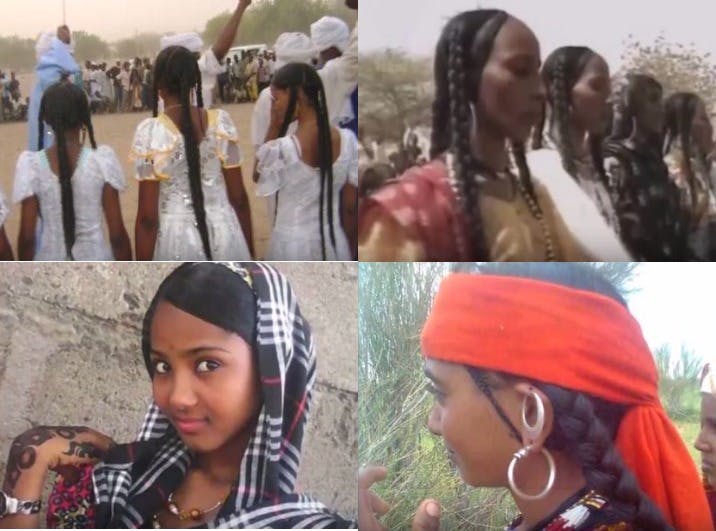
5.Tuareg of Southern Libya (Ghadames): Hair Types 2a -4c (extremely diverse group with a very wide variety of hair types)
6.Fulani & Wodaabe Tribe: Hair type range from 4a -4C
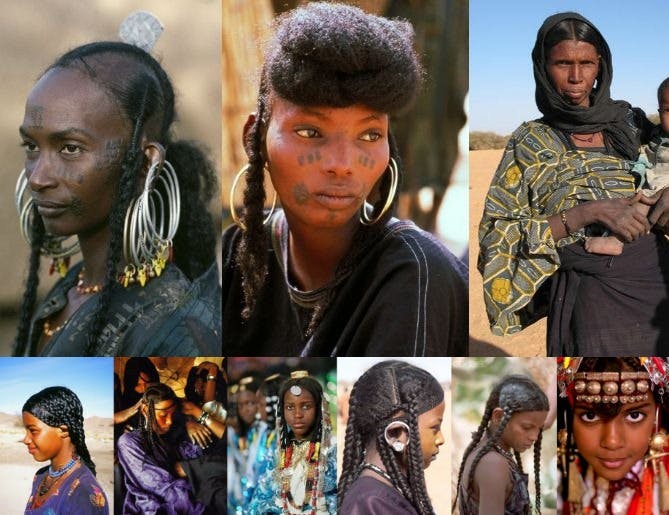
Do All The tribes In The Sahel Use Shebe Seeds/ Chebe Powder For Natural Hair Growth?
From what I understand from the information given by Miss Sahel, it seems to be only the tribes based in Chad & Sudan that use this mixture, such as the Tebou & Basara. It is possible that the Shuwa Arabs of Nigeria may use it, as they are somewhat related to the Basara Arabs.
Miss Sahel also mentions that Chebe is only worn by married women and it is used as an anti shrinkage product. So we can assume it is a product that has a significant cultural value in Chad – maybe a traditional rite of passage.
Although I am uncertain about the use of Chebe by other tribes in the Sahel region, one thing I am certain about is that most, if not all of them, braid and oil their hair. Whilst many use their own local herbs.
Is Their Natural Hair Growth Attributed to Mixture With Berbers & Arabs?
Don’t let the term ‘Arab’ fool you into thinking that their hair is only long due to admixture. No doubt many humans are generally ‘mixed’ but the length of your hair is not entirely determined by genetics but rather your hair care regime and the ingredients you use. Don’t forget that there are many black women in America, (which DNA test shows that they are mixed), also struggle with hair growth. With that being said, let us now dispell that myth that you have to be mixed to grow long hair.
All across Africa, women have braided their hair for centuries, but drenching hair with oils before braiding seems more customary in the Sahel region. Scented oils are very popular within Arab culture. So it could be a combination of Chebe, genetics, and proper hair care maintenance that results in such long lengths of the Basara Arab people.
Does Chebe Seeds/ Chebe Powder Grow Natural Hair?(Croton Zambesicus)
Miss Sahel Vlogs states in one of her videos that Chebe powder doesn’t grow hair, rather it helps hair to retain moisture, which ultimately promotes hair growth.
When analysing the Basara women and their hair, it is worth noting that the front section of their hair is short. They claim that this is the area where the Chebe powder is not applied, hence the short length. But the area the Chebe powder is applied, their hair length exceeds over 30 inches.
Interestingly enough, they also seem to drench the back of their hair with more oils than they do on the front. So it is hard to say if it is the Chebe or the oils that is responsible for such growth.
Will Chebe Powder Work for Natural Hair Growth On 4C Afro Hair?
It is hard to say, the only way to know is to try it. However, it is important to note that the thing that should make length and moisture retention easier for the Basara and Tebou women is that many of them have curls that are slightly looser than the typical kinky 4C hair texture. It’s not that women with 4C hair can’t grow hair, it is more so that we have more trouble retaining our length. I myself have tail bone length 4C, however, I retain my length with blow drying.
For many of us 4C kinky haired girls, who have hair that is thicker and more prone to breakage, our hair sucks up moisture very fast. So if you have 4c hair and want to use Chebe powder, I think it is best to braid your hair into at least 6 braids on each side of your head, rather than just 3 braids like the Basara Arabs. With more braids, you ensure that your hair stays well moisturised. With only 3 braids, I am not sure if it will have any benefits at all, unless you stretch your hair out first by blow drying with warm hair, then braid it. If you want to use Chebe to loosen your 4C texture, then I very much doubt it will work. Only chemicals can do that.
Is Their Natural Hair Growth Attributed to Chebe Powder Or Their Protective Styling Methods?
Based on my experience, it is the extensive oiling and protective styling with braids that seems to play the biggest role in their fast hair growth. Braiding keeps the hair moisture locked in, and if you blow dry like I do, your length stays retained.
As mentioned earlier, I am 100% Southern Nigerian (Igbo) with tail bone length 4C hair. Most DNA tests show that no Arab admixture is found in Southern Nigeria and we are predominantly Bantu derived. However, I have copied the oiling and braiding techniques of the Sahelian tribes with successful results (without the use of Chebe). I learned their techniques during my time spent in Northern Nigeria and I made a video about this a few years back. It was called ‘Fulani Silk Wrap’. Watch it here.
See the image of my hair on the left (or above if you are reading this on a cell phone). Note that my hair was blow dried before braiding. My natural texture is 4b/c and my hair has 50% shrinkage when wet). After my weekly wash, I blow dry my hair on cold or warm air to stretch it, which also mimics the dry heat of the Sahel region. I then add a thin layer of oil or leave in, then braid my hair. That’s pretty much it. You can air dry your hair if you prefer not to use a blow drier.
My overall opinion is that if you are newly natural, why not experiment with as many different ingredients as you can, so as to find out what best suits your hair. Chebe seems very promising indeed.
I personally will not use Chebe on my hair, as my 4C hair does not like any heavy products on it. I have experienced serious breakage in the past when I applied hair masks and heavy creams to my hair. I personally feel that lighter leave-ins and castor oil/coconut oil/shea butter work better for my 4C hair but everyone’s hair is different.
Chebe Powder Ingredients – For Natural Hair Growth
The ingredients needed to make Chebe powder are:.
Chébé seeds (Lavender croton)
Mahalaba – Arabic word for cherry plant. The kernals are used to produce traditional perfumes.
Misic – This is the Arabic word for musk, used for scent
Samour/Samough is the Arabic word for Mastic gum, very popular in Sudan and Turkey
Sudanese Khumra Perfume oil
Cloves
Keep note that they are not using any leave in moisturisers, they simply use Chebe, Clove, Mastic Gum (Samour) & oils, so take precaution and avoid combining other products in the mixture as you don’t know how they will react. Also, you wouldn’t want your 4C hair getting too sticky or gluey, as they will cause breakage. If you are not familiar with Mastic Gum, it is a natural but very sticky residue that acts like glue, often used as chewing gum in Sudan and Turkey. (I used to chew it after meals when I visit Turkey). So please experiment only a small area of your hair to prevent your strands sticking together.
How to Apply Shebe/ Chebe Powder – Hot Oil Treatment For Natural Hair Growth
They grill the seeds, then pound and sieve to obtain a powder. They wet the hair with water, then apply the powder, followed by the oil or pomade. Braid it up. Repeat every five days. For more information on doing a hot oil treatment, read my article: Hot Oil Treatment for Natural Hair Growth.
Where to Buy Chebe Powder Online?
You can purchase Chebe powder from our hair shop. We ship to North America – USA & Canada, UK, Australia, Europe, France, Portugal, Germany, Ireland, England, Italy. She will tell you more.
More Ayurvedic Herbs & Powders for Natural Hair
You can read more about using ayurvedic herbs and powders for natural hair in the article titled: Ayurvedic herbs for natural hair.
Other Best Oils for Natural Hair Growth
For more information on using oils for natural hair growth, check out my other articles on:
- Coconut oil for natural hair growth
- Rosemary oil for natural hair growth
- Moringa oil for natural hair growth
- Olive oil for natural hair growth on black hair
- Argan oil for natural hair growth
- Homemade hot oil treatment for natural hair growth
- Castor oil for natural hair growth on black hair
- Hemp oil for natural hair growth
- Best oils for natural hair growth
- Shea butter for natural hair growth
- Best essential oils for natural black hair growth
More Information on the Best Herbal Remedies for Natural Hair Growth
- Chebe powder for natural hair growth
- Fenugreek for natural hair growth
- Ayurvedic herbs for natural hair.
- Herbal oil treatment for natural hair growth
More Tips: How to Grow Natural Black Hair Fast
For more information on how to grow natural hair please read the article: How to Grow Natural Hair. Here are some other important factors that influence hair growth.


